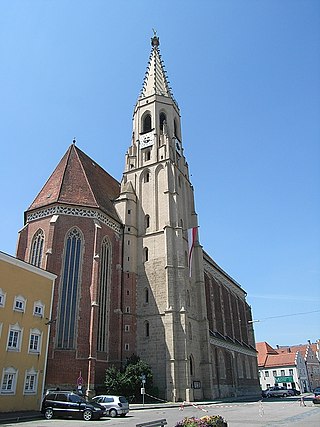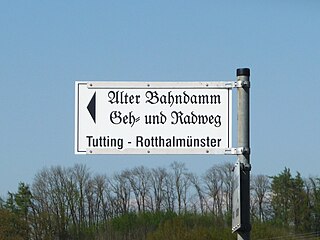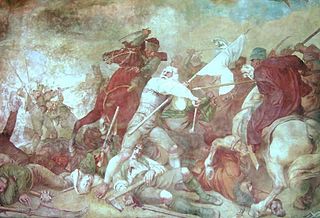
Braunau am Inn is a town in Upper Austria on the border with Germany. It is known for being the birthplace of Adolf Hitler.

The Inn is a river in Switzerland, Austria and Germany. The 518 km (322 mi) long river is a right tributary of the Danube, being the third largest tributary of the Danube by discharge. The highest point of its drainage basin is the summit of Piz Bernina at 4,049 m (13,284 ft). The Engadine, the valley of the En, is the only Swiss valley whose waters end up in the Black Sea.

Marktl, or often unofficially called Marktl am Inn, is a village and historic market municipality in the state of Bavaria, Germany, near the Austrian border, in the Altötting district of Upper Bavaria. The most notable neighbouring town is Altötting. Marktl has approximately 2,800 inhabitants.

Bundesautobahn 94 is an autobahn in southern Germany. When completed, it will connect Munich with Passau. Currently, only the parts Munich-Burghausen, and Malching-Kirchham have been built. Between Burghausen and Simbach am Inn, there is a 14 kilometer, two-lane section that is signed as Bundesstraße 12. Provisions for an upgrade to A 94 exist here.

The Innviertel is a traditional Austrian region southeast of the Inn river. It forms the western part of the state of Upper Austria and borders the German state of Bavaria. The Innviertel is one of the four traditional "quarters" of Upper Austria, the others being Hausruckviertel, Mühlviertel, and Traunviertel.

Simbach am Inn is a town on the River Inn in the Rottal-Inn district of Bavaria, Germany. The Austrian city Braunau am Inn lies on the opposite side of the river from Simbach.

Neuötting is a town in the district of Altötting, in Bavaria, Germany. It is situated on the river Inn, 2 km north of Altötting, about 70 km north of Salzburg, 80 southwest of Passau and almost 100 km east of Munich. It is a stop on the railway line between Munich and Simbach.
The Bavarian Class PtzL 3/4 engines with the Royal Bavarian State Railways were rack railway locomotives whose cogwheel drive was designed for working on tracks with a Strub rack. In 1923 they were incorporated by the Deutsche Reichsbahn as DRG Class 97.1 in their numbering plan. The locomotives remained on their regular route between Erlau and Wegscheid until the closure of this rack railway in 1963. The last journey was on 5 January 1963. They were scrapped in April 1964 at Simbach am Inn.
Reichsbahndirektion München was a Deutsche Reichsbahn railway division within the Bavarian Group Administration in southern Germany with its headquarters in Munich, Bavaria.

The Passau–Neumarkt-Sankt Veit railway or Rott Valley Railway (Rottalbahn) is a single-tracked, unelectrified branch line in southeastern Bavaria in Germany. At 98 kilometres it is the longest branch line in Bavaria.

The Isen is a small river in southeast Upper Bavaria with a length of about 81 kilometres. The Isen rises near Lacken and flows through one of the most unspoiled regions of Old Bavaria (Altbayern): the Isen Valley.
The Mühldorf–Simbach am Inn railway is a 39 km long, single-tracked, unelectrified main line in Bavaria in southern Germany.
Hans Friedrich Zacher was a German academician. He was a professor at the Ludwig Maximilian University of Munich and was the President of the Max Planck Society from 1990 till 1996.

The Tutting–Kößlarn railway was a branch line from Tutting, in the municipality of Kirchham, to Kößlarn in the province of Lower Bavaria in southern Germany.

The Simbach am Inn–Pocking railway was a single-tracked branch line between Simbach am Inn and Pocking in the province of Lower Bavaria in southern Germany.

The Bavarian uprising of 1705–1706 was a revolt against the occupation of the Electorate of Bavaria by the Imperial Army of the Habsburg Monarchy during the War of the Spanish Succession (1701–1714). It lasted from early November 1705 to 18 January 1706, approximately 75 days. Henric L. Wuermeling speaks of this as "the first revolution of modern history."

Mühldorf (Oberbayern) station is a railway junction and station in the district town of Mühldorf in the German state of Bavaria. The station has seven platform tracks and is classified by Deutsche Bahn as a category 4 station. The station is served by 105 passenger trains each day operated by the Südostbayernbahn and frequented by about 10,000 travellers. It is also the central station of the “Bavarian Chemical Triangle”. About 800 freight wagons are dispatched from it daily.
The Mühldorf–Freilassing railway is a major railway in Bavaria. The line, which is operated by the Südostbayernbahn (SOB), runs from Mühldorf to Freilassing in the German state of Bavaria.

E 552 is a B-class European route connecting Munich in Germany to Linz in Austria. The route is approximately 243 km long.

The Kirchdorf Wildcats are an American football team in Kirchdorf am Inn, Germany. The club's greatest success came in 2017 when it won the southern division of the German Football League 2 and earned the right to play-off for promotion to the German Football League which they won against the Saarland Hurricanes.














